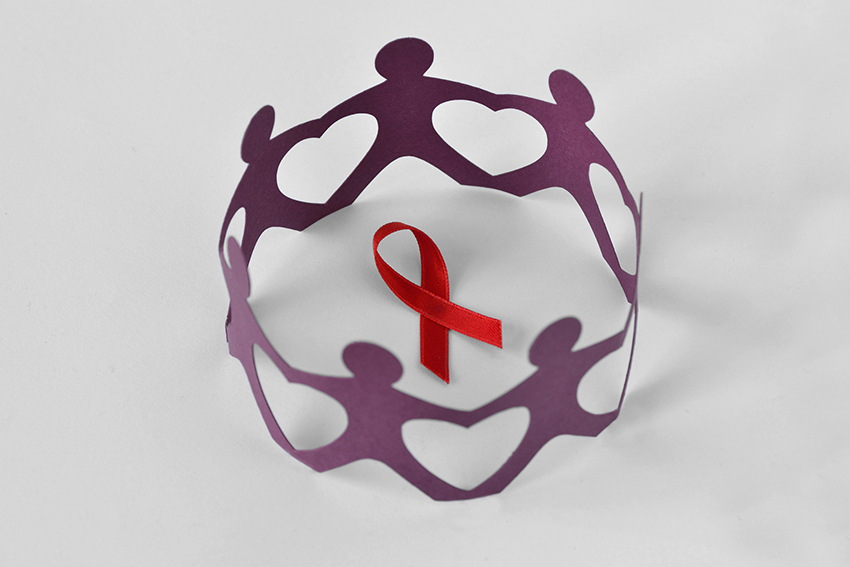
In 2019 and 2020, UCLA in collaboration with Loma Linda University (co-investigator: Alex Dubov) received an award from the National Institute of Mental Health to engage in a regional effort for a coordinated Ending the HIV Epidemic (EHE) response in California. EHE is an initiative by the United States Department of Health and Human Services (HHS) that aim to reduce human immunodeficiency virus (HIV) incidence in the United States by 90% within ten years by focusing on 48 high-burden US counties.[1] San Bernardino and Riverside (together with Los Angeles and Orange) Counties are among these 48 'hotspot' counties identified by the HHS. More than 14,000 individuals are living with HIV in the Inland Empire area. Between 2014 and 2018, the annual number of new HIV diagnoses in the region increased by 23%, with 79% of these diagnoses being among non-White patients.[2]
The shared boundaries and interconnectedness in this four-county region call for regional collaboration and coordination among health jurisdictions, community groups, and other stakeholders working to address the HIV epidemic. Yet, HIV care and prevention funding is awarded to health departments by county. Partnerships with community-based organizations and healthcare providers – crucial in implementing a unified approach to HIV surveillance and coordinated interventions – are also restricted by these geographically defined boundaries.
To address this issue, the UCLA Center for HIV Identification, Prevention, and Treatment Services (CHIPTS) facilitated a regional stakeholder meeting on January 24, 2020, with over 150 stakeholders in attendance. Through an iterative thematic analysis of meeting materials, key recommendations on reaching EHE goals in the region emerged. The recommendations below reflect the ten steps required to achieve EHE goals in the region:[3]
- Develop infrastructures to support regional information sharing and collaboration. HIV surveillance data are not centralized in California. While sharing data across local health jurisdictions is legally allowed, there is a lack of systems to effectively facilitate this process, and data privacy concerns persist. The region needs access to individual-level HIV surveillance data across jurisdictional lines to ensure successful linkage to care.
- Implement routine HIV screening in the emergency department (ED). The proportion of undiagnosed infections in the Inland Empire remains high (18%) and unchanged. Over 80% of new HIV infections can be traced to undiagnosed individuals or people who are diagnosed but not engaged in care.[4] EDs are often the primary source of care for these individuals experiencing health disparities who are at risk for HIV transmission or acquisition.
- Increase access to biomedical prevention, especially among populations most at-risk for HIV. Modeling studies suggest 30%-50% pre-exposure prophylaxis (PrEP) coverage among men who have sex with men (MSM) is required to achieve a 10-year reduction in HIV incidence of 25%.[5] Yet, only 6% of PrEP-eligible MSM in Riverside County and 8% of PrEP-eligible MSM in San Bernardino County are currently using PrEP.[6]
- Expand rapid antiretroviral therapy (ART) initiation and linkage to HIV care. Nationally, there is a linkage to HIV care goal of at least 85% within 30 days of diagnosis.[7] This number stands at 73% in the Inland Empire.[8]
- Develop medical care coordination able to mitigate the effects of homelessness, poor mental health, and substance misuse. The HIV incidence rate among unstably housed people is nearly five-fold the rate among the general population.[9] Among people with HIV (PWH) in the region in 2016, 10.8% experienced homelessness in the past 12 months.[10] Moreover, approximately half of HIV-positive patients in the region have major depressive symptoms.[11] Problematic substance use presents an added, intersectional concern.
- Support programming that addresses the magnitude of challenges posed by poverty and incarceration. Approximately 13% of people residing in the region lived in poverty in 2019 (the national poverty rate is 11.8%).[12] High rates of poverty are also associated with incarceration. The prison population rates of Riverside County (631 per 100,000) and San Bernardino County (536 per 100,000) are significantly higher than the CA state rate of 486 per 100,000.[13] Many jails and prisons provide ART to PWH; however, maintaining ART use during and after the transition out of jail or prison is extremely challenging.
- Implement provider-level interventions to improve service delivery across the HIV care continuum. Healthcare providers across the region, particularly primary care providers who do not specialize in HIV and clinicians in more rural and culturally conservative communities, need additional education and support on key topics related to HIV prevention and care. Education and training are especially critical, given that multiple counties within the region are experiencing shortages of HIV specialty providers to treat PWH. For instance, there are 1,136 PWH covered by Medi-Cal in Orange County, yet only 29 HIV providers accept Medi-Cal.[14]
- Improve competency of HIV prevention and care for Black men and women. According to the Centers for Disease Control and Prevention (CDC), nearly half of all Black gay men in the US will get HIV in their lifetime.[15] African Americans in the region experience disparities at all stages of the HIV care continuum – more likely to be unaware of their infection; to experience lower rates of HIV care linkage and retention after diagnosis; and to adhere to ART and attain viral suppression.[16] There is a need to design and implement targeted and tailored interventions specifically for African Americans while not exacerbating HIV-related stigma associated with targeted interventions.
- Expand access to treatment and related services through innovative service delivery models, targeting demographics and geographic areas where populations are at higher risk. A lack of healthcare service sites and healthcare providers fuels healthcare access issues in the region – particularly in the geographically massive and decentralized San Bernardino and Riverside Counties. In both counties, services are widely dispersed, sometimes requiring trips of up to 40 miles to get to a provider.[17] The Health Resources and Services Administration (HRSA) has designated San Bernardino County as a Medically Underserved Area (MUA) and a Health Professional Shortage Area (HPSA).
- Establish programs to eliminate stigma and educate the community about HIV. Systemic discrimination and stigma have profound impacts on health-seeking behaviors and health outcomes among populations most impacted by HIV and contribute to the related epidemics of substance use and mental illness. Interventions that actively address experienced and perceived stigma are required to disrupt the HIV epidemic across the region.
These recommendations represent a consensus to direct a regional approach to HIV care and prevention in Southern California. Modeling efforts have shown that the region will continue to see no change in new HIV diagnoses over the next 25 years if HIV prevention efforts remain at 2012-2015 levels.[18] The lack of appreciable decline in new HIV cases despite the investment over the years calls for a different strategy involving regional collaboration. Taking a regionally focused response to HIV has substantially greater public health benefits compared to a "silo-ed" approach at the same investment level. The consensus recommendations highlighted above denote regional priorities for surveillance, identification, prevention, and treatment and suggest ways to tailor them to meet the needs of the communities at greatest risk
Author Bio:

Alex Dubov, PhD
Dr. Dubov is an Associate Professor for the School of Behavioral Health. His research interests lie in applying scientifically rigorous approaches (i.e. conjoint analysis) to better understand and improve both patient and physician decision making. He is also interested in leveraging emerging technologies as innovative approaches for supporting the implementation of combination (biomedical, behavioral, health system) interventions to prevent HIV infection among groups that are epidemiologically at high-risk for infection and whose prevention needs are complicated by their socially marginalized statuses in their communities.
References:
[1] Fauci, A. S., Redfield, R. R., Sigounas, G., Weahkee, M. D., & Giroir, B. P. (2019). Ending the HIV epidemic: a plan for the United States. JAMA, 321(9), 844-845.
[2] CDPH. (2018). California HIV Surveillance Report 2018. https://www.cdph.ca.gov/Programs/CID/DOA/CDPH%20Document%20Library/California_HIV_Surveillance_Report2018.pdf
[3] Dubov, A., Rosenberg-Carlson, E., Kao, U., Swendeman, D., Donohoe, T., Landovitz, R.J., Garland, W., Shoptaw, S., (2021). A regional response to End the HIV Epidemic in Southern California: Key Recommendations. PLoS One (in press)
[4] CDPH. (2019). California Consortium for CDC PS19-1906: Alameda, Orange, Riverside, Sacramento, San Bernardino, and San Diego counties.
[5] Sullivan, P. S., Carballo-Diéguez, A., Coates, T., Goodreau, S. M., McGowan, I., Sanders, E. J., ... & Sanchez, J. (2012). Successes and challenges of HIV prevention in men who have sex with men. The Lancet, 380(9839), 388-399.
[6] Sullivan, P. S., Mouhanna, F., Mera, R., Pembleton, E., Castel, A. D., Jaggi, C., ... & Siegler, A. J. (2020). Methods for county-level estimation of pre-exposure prophylaxis coverage and application to the US Ending the HIV Epidemic jurisdictions. Annals of epidemiology, 44, 16-30.
[7] Jain, K. M., Maulsby, C., Kinsky, S., Charles, V., Holtgrave, D. R., & PC Implementation Team. (2016). 2015–2020 national HIV/AIDS strategy goals for HIV linkage and retention in care: recommendations from program implementers.
[8] AHEAD. (2019). America’s HIV Epidemic Analysis Dashboard. https://ahead.hiv.gov/
[9] SFDPH. (2017). HIV Epidemiology annual report 2017. https://www.sfdph.org/dph/comupg/oprograms/HIVepiSec/HIVepiSecReports.a…
[10] CDPH. (2015). Estimate of past year homelessness, Medical Monitoring Project (MMP) California Project Area 2015-2016
[11] Holloway, I. W., Tan, D., Dunlap, S. L., Palmer, L., Beougher, S., & Cederbaum, J. A. (2017). Network support, technology use, depression, and ART adherence among HIV-positive MSM of color. AIDS care, 29(9), 1153-1161.
[12] Public Policy Institute of California. (2019). Poverty in California. https://www.ppic.org/publication/poverty-in-california/
[13] California Sentencing Institute. (2016). State prison population. http://casi.cjcj.org/Adult/
[14] CDPH. (2019). California Consortium for CDC PS19-1906: Alameda, Orange, Riverside, Sacramento, San Bernardino, and San Diego counties.
[15] Hess, K. L., Hu, X., Lansky, A., Mermin, J., & Hall, H. I. (2017). Lifetime risk of a diagnosis of HIV infection in the United States. Annals of epidemiology, 27(4), 238-243.
[16] Freeman, R., Gwadz, M. V., Silverman, E., Kutnick, A., Leonard, N. R., Ritchie, A. S., ... & Martinez, B. Y. (2017). Critical race theory as a tool for understanding poor engagement along the HIV care continuum among African American/Black and Hispanic persons living with HIV in the United States: a qualitative exploration. International journal for equity in health, 16(1), 1-14.
[17] Nguyen, A., van Meijgaard, J., Kim, S., & Marsh, T. (2021) Mapping healthcare deserts. https://www.goodrx.com/healthcare-access/research/healthcare-deserts-80-percent-of-country-lacks-adequate-healthcare-access
[18] Nosyk, B., Zang, X., Krebs, E., Enns, B., Min, J. E., Behrends, C. N., ... & Montaner, J. (2020). Ending the HIV epidemic in the USA: an economic modelling study in six cities. The lancet HIV, 7(7), e491-e503.
